Hybrid Photonic Integrated Circuits for Wireless Transceivers
Abstract
1. Introduction
2. Key Photonic Subsystems for Wireless Transceiver PICs
- Optical injection-locked laser source for wireless communications
- Photonic THz emitter and receiver
- Beam steering with OPA and optical beam-forming network (OBFN)
2.1. Optical Injection-Locked Laser Source for Wireless Communications
2.1.1. InP/Polymer Tunable Laser
2.1.2. InP Electro-Optic Modulator
2.1.3. Optical Isolators
2.2. Photonic THz Emitter and Receiver
Scaling-Up with Antenna Arrays
2.3. Beam Steering with OPA and OBFN
3. Towards Full-Photonic Wireless Transmitter and Receiver PICs
3.1. Optical Interfacing Between PIC Technologies
3.2. Hybrid Wireless Transmitter PIC
3.3. Hybrid Wireless Receiver PIC
4. Discussion
5. Conclusions
Author Contributions
Funding
Institutional Review Board Statement
Informed Consent Statement
Data Availability Statement
Acknowledgments
Conflicts of Interest
References
- Leitenstorfer, A.; Moskalenko, A.S.; Kampfrath, T.; Kono, J.; Castro-Camus, E.; Peng, K.; Qureshi, N.; Turchinovich, D.; Tanaka, K.; Markelz, A.G.; et al. The 2023 terahertz science and technology roadmap. J. Phys. D Appl. Phys. 2023, 56, 223001. [Google Scholar] [CrossRef]
- Song, H.-J.; Lee, N. Terahertz Communications: Challenges in the Next Decade. IEEE Trans. Terahertz Sci. Technol. 2022, 12, 105–117. [Google Scholar] [CrossRef]
- Nagatsuma, T.; Ducournau, G.; Renaud, C.C. Advances in terahertz communications accelerated by photonics. Nat. Photonics 2016, 10, 371–379. [Google Scholar] [CrossRef]
- Song, H.-J.; Nagatsuma, T. Present and Future of Terahertz Communications. IEEE Trans. Terahertz Sci. Technol. 2011, 1, 256–263. [Google Scholar] [CrossRef]
- Nagatsuma, T.; Carpintero, G. Recent Progress and Future Prospect of Photonics-Enabled Terahertz Communications Research. IEICE Trans. Electron. 2015, 98, 1060–1070. [Google Scholar] [CrossRef]
- Seeds, A.J.; Shams, H.; Fice, M.J.; Renaud, C.C. TeraHertz Photonics for Wireless Communications. J. Lightwave Technol. 2015, 33, 579–587. [Google Scholar] [CrossRef]
- Degli-Eredi, I.; An, P.; Drasbæk, J.; Mohammadhosseini, H.; Nielsen, L.; Tønning, P.; Rommel, S.; Monroy, I.T.; Heck, M.J.R. Millimeter-wave generation using hybrid silicon photonics. J. Opt. 2021, 23, 43001. [Google Scholar] [CrossRef]
- Safian, R.; Ghazi, G.; Mohammadian, N. Review of photomixing continuous-wave terahertz systems and current application trends in terahertz domain. Opt. Eng. 2019, 58, 1. [Google Scholar] [CrossRef]
- Brown, E.R. THz Generation by Photomixing in Ultrafast Photoconductors. Int. J. High Speed Electron. Syst. 2003, 13, 497–545. [Google Scholar] [CrossRef]
- Li, X.; Yu, J.; Zhang, J.; Dong, Z.; Li, F.; Chi, N. A 400G optical wireless integration delivery system. Opt. Express 2013, 21, 18812–18819. [Google Scholar] [CrossRef]
- Siew, S.Y.; Li, B.; Gao, F.; Zheng, H.Y.; Zhang, W.; Guo, P.; Xie, S.W.; Song, A.; Dong, B.; Luo, L.W.; et al. Review of Silicon Photonics Technology and Platform Development. J. Lightwave Technol. 2021, 39, 4374–4389. [Google Scholar] [CrossRef]
- Rahim, A.; Hermans, A.; Wohlfeil, B.; Petousi, D.; Kuyken, B.; van Thourhout, D.; Baets, R. Taking silicon photonics modulators to a higher performance level: State-of-the-art and a review of new technologies. Adv. Photonics 2021, 3, 24003. [Google Scholar] [CrossRef]
- Besancon, C.; Néel, D.; Make, D.; Ramírez, J.M.; Cerulo, G.; Vaissiere, N.; Bitauld, D.; Pommereau, F.; Fournel, F.; Dupré, C.; et al. AlGaInAs Multi-Quantum Well Lasers on Silicon-on-Insulator Photonic Integrated Circuits Based on InP-Seed-Bonding and Epitaxial Regrowth. Appl. Sci. 2022, 12, 263. [Google Scholar] [CrossRef]
- Xiang, C.; Jin, W.; Huang, D.; Tran, M.A.; Guo, J.; Wan, Y.; Xie, W.; Kurczveil, G.; Netherton, A.M.; Liang, D.; et al. High-Performance Silicon Photonics Using Heterogeneous Integration. IEEE J. Sel. Top. Quantum Electron. 2022, 28, 8200515. [Google Scholar] [CrossRef]
- Gupta, Y.D.; Binet, G.; Diels, W.; Abdeen, O.; Gaertner, T.; Baier, M.; Schell, M. Implementation, Modelling and Verification of High-Speed Mach-Zehnder Phase Modulators in an Open Access InP Foundry Platform. J. Lightwave Technol. 2023, 41, 3498–3504. [Google Scholar] [CrossRef]
- Soares, F.; Baier, M.; Gaertner, T.; Grote, N.; Moehrle, M.; Beckerwerth, T.; Runge, P.; Schell, M. InP-Based Foundry PICs for Optical Interconnects. Appl. Sci. 2019, 9, 1588. [Google Scholar] [CrossRef]
- Roeloffzen, C.G.H.; Hoekman, M.; Klein, E.J.; Wevers, L.S.; Timens, R.B.; Marchenko, D.; Geskus, D.; Dekker, R.; Alippi, A.; Grootjans, R.; et al. Low-Loss Si3N4 TriPleX Optical Waveguides: Technology and Applications Overview. IEEE J. Sel. Top. Quantum Electron. 2018, 24, 4400321. [Google Scholar] [CrossRef]
- Buzaverov, K.A.; Baburin, A.S.; Sergeev, E.V.; Avdeev, S.S.; Lotkov, E.S.; Bukatin, S.V.; Stepanov, I.A.; Kramarenko, A.B.; Amiraslanov, A.S.; Kushnev, D.V.; et al. Silicon Nitride Integrated Photonics from Visible to Mid-Infrared Spectra. Laser Photonics Rev. 2024, 18, 2400508. [Google Scholar] [CrossRef]
- Kleinert, M.; Nuck, M.; Conradi, H.; De Felipe, D.; Kresse, M.; Brinker, W.; Zawadzki, C.; Keil, N.; Schell, M. A platform approach towards hybrid photonic integration and assembly for communications, sensing, and quantum technologies based on a polymer waveguide technology. In Proceedings of the 2019 IEEE CPMT Symposium Japan (ICSJ), Kyoto, Japan, 18–20 November 2019; pp. 25–30. [Google Scholar]
- Dangel, R.; La Porta, A.; Jubin, D.; Horst, F.; Meier, N.; Seifried, M.; Offrein, B.J. Polymer Waveguides Enabling Scalable Low-Loss Adiabatic Optical Coupling for Silicon Photonics. IEEE J. Sel. Top. Quantum Electron. 2018, 24, 8200211. [Google Scholar] [CrossRef]
- Chen, G.; Gao, Y.; Lin, H.-L.; Danner, A.J. Compact and Efficient Thin-Film Lithium Niobate Modulators. Adv. Photonics Res. 2023, 4, 2300229. [Google Scholar] [CrossRef]
- Honardoost, A.; Abdelsalam, K.; Fathpour, S. Rejuvenating a Versatile Photonic Material: Thin-Film Lithium Niobate. Laser Photonics Rev. 2020, 14, 2000088. [Google Scholar] [CrossRef]
- Zhu, D.; Shao, L.; Yu, M.; Cheng, R.; Desiatov, B.; Xin, C.J.; Hu, Y.; Holzgrafe, J.; Ghosh, S.; Shams-Ansari, A.; et al. Integrated photonics on thin-film lithium niobate. Adv. Opt. Photonics 2021, 13, 242. [Google Scholar] [CrossRef]
- Sattari, H.; Prieto, I.; Zarebidaki, H.; Leo, J.; Choong, G.; Arefi, F.; Orvietani, M.; Della Torre, A.; Mettraux, A.; Dubois, F.; et al. Thin-film lithium niobate PICs: Advancements and potential applications in telecom and beyond. In Integrated Photonics Platforms III; SPIE: Strasbourg, France, 2024; pp. 86–89. [Google Scholar]
- Burla, M.; Hoessbacher, C.; Heni, W.; Haffner, C.; Fedoryshyn, Y.; Werner, D.; Watanabe, T.; Massler, H.; Elder, D.L.; Dalton, L.R.; et al. 500 GHz plasmonic Mach-Zehnder modulator enabling sub-THz microwave photonics. APL Photonics 2019, 4, 056106. [Google Scholar] [CrossRef]
- Andrianopoulos, E.; Tokas, K.; Felipe, D.d.; Theurer, M.; Weigel, M.; Pagano, A.; Kanta, K.; Kresse, M.; Megas, G.; Tsokos, C.; et al. Integrated 800 Gb/s O-band WDM optical transceiver enabled by hybrid InP-polymer photonic integration. J. Opt. Commun. Netw. 2024, 16, D44. [Google Scholar] [CrossRef]
- Qian, T.; Deumer, M.; Gupta, Y.D.; Nellen, S.; Schuler, B.; Conradi, H.; Kresse, M.; Reck, J.; Mihov, K.; Kleinert, M.; et al. Hybrid Polymer THz Receiver PIC with Waveguide Integrated Photoconductive Antenna: Concept and 1st Characterization Results. In Proceedings of the Optical Fiber Communication Conference (OFC) 2022, San Diego, CA, USA, 6–10 March 2022; W3D.6. ISBN 978-1-55752-466-9. [Google Scholar]
- Conradi, H.; Qian, T.; Kresse, M.; Reck, J.; de Felipe, D.; Kleinert, M.; Weigel, M.; Zawadzki, C.; Keil, N.; Schell, M. Tunable DBR Laser with Integrated Optical Isolator. In Proceedings of the Optical Fiber Communications Conference (OFC) 2021, San Francisco, CA, USA, 6–10 June 2021; pp. 1–3, ISBN 978-1-943580-86-6. [Google Scholar]
- Kleinert, M.; de Felipe, D.; Conradi, H.; Kresse, M.; Jehle, L.; Weigel, M.; Qian, T.; Mihov, K.; Reck, J.; Zawadzki, C.; et al. Hybrid Polymer Integration for Communications, Sensing and Quantum Technologies from the Visible to the Infrared. In Proceedings of the 2021 European Conference on Optical Communication (ECOC), Bordeaux, France, 13–16 September 2021; pp. 1–4, ISBN 978-1-6654-3868-1. [Google Scholar]
- Yao, J. Microwave Photonic Systems. J. Lightwave Technol. 2022, 40, 6595–6607. [Google Scholar] [CrossRef]
- Yao, J. Microwave Photonics. J. Lightwave Technol. 2009, 27, 314–335. [Google Scholar] [CrossRef]
- Fan, Y.; Oldenbeuving, R.M.; Roeloffzen, C.G.; Hoekman, M.; Geskus, D.; Heideman, R.G.; Boller, K.-J. 290 Hz Intrinsic Linewidth from an Integrated Optical Chip-based Widely Tunable InP-Si3N4 Hybrid Laser. In Proceedings of the Conference on Lasers and Electro-Optics, Washington, DC, USA, 25–29 June 2017. JTh5C.9. [Google Scholar]
- De Felipe, D.; Zhang, Z.; Brinker, W.; Kleinert, M.; Novo, A.M.; Zawadzki, C.; Moehrle, M.; Keil, N. Polymer-Based External Cavity Lasers: Tuning Efficiency, Reliability, and Polarization Diversity. IEEE Photonics Technol. Lett. 2014, 26, 1391–1394. [Google Scholar] [CrossRef]
- Xiang, C.; Morton, P.A.; Bowers, J.E. Ultra-narrow linewidth laser based on a semiconductor gain chip and extended Si3N4 Bragg grating. Opt. Lett. 2019, 44, 3825–3828. [Google Scholar] [CrossRef]
- Kharas, D.; Plant, J.J.; Loh, W.; Swint, R.B.; Bramhavar, S.; Heidelberger, C.; Yegnanarayanan, S.; Juodawlkis, P.W. High-Power (>300 mW) On-Chip Laser With Passively Aligned Silicon-Nitride Waveguide DBR Cavity. IEEE Photonics J. 2020, 12, 1504612. [Google Scholar] [CrossRef]
- Zhang, Y.; Yang, S.; Guan, H.; Lim, A.E.-J.; Lo, G.-Q.; Magill, P.; Baehr-Jones, T.; Hochberg, M. Sagnac loop mirror and micro-ring based laser cavity for silicon-on-insulator. Opt. Express 2014, 22, 17872–17879. [Google Scholar] [CrossRef]
- Tang, R.; Kita, T.; Yamada, H. Narrow-spectral-linewidth silicon photonic wavelength-tunable laser with highly asymmetric Mach-Zehnder interferometer. Opt. Lett. 2015, 40, 1504–1507. [Google Scholar] [CrossRef] [PubMed]
- Debregeas, H.; Ferrari, C.; Cappuzzo, M.A.; Klemens, F.; Keller, R.; Pardo, F.; Bolle, C.; Xie, C.; Earnshaw, M.P. 2kHz Linewidth C-Band Tunable Laser by Hybrid Integration of Reflective SOA and SiO2 PLC External Cavity. In Proceedings of the 2014 International Semiconductor Laser Conference, Palma de Mallorca, Spain, 7–10 September 2014; pp. 50–51. [Google Scholar]
- Maier, P.; Chen, Y.; Xu, Y.; Bao, Y.; Blaicher, M.; Geskus, D.; Dekker, R.; Liu, J.; Dietrich, P.-I.; Peng, H.; et al. Sub-kHz-Linewidth External-Cavity Laser (ECL) With Si3N4 Resonator Used as a Tunable Pump for a Kerr Frequency Comb. J. Lightwave Technol. 2023, 41, 3479–3490. [Google Scholar] [CrossRef]
- Xiang, C.; Guo, J.; Jin, W.; Wu, L.; Peters, J.; Xie, W.; Chang, L.; Shen, B.; Wang, H.; Yang, Q.-F.; et al. High-performance lasers for fully integrated silicon nitride photonics. Nat. Commun. 2021, 12, 6650. [Google Scholar] [CrossRef] [PubMed]
- De Felipe, D.; Happach, M.; Nellen, S.; Brinker, W.; Kleinert, M.; Zawadzki, C.; Möhrle, M.; Keil, N.; Göbel, T.; Petermann, K.; et al. Hybrid polymer/InP dual DBR laser for 1.5 μm continuous-wave terahertz systems. In Proceedings of the Terahertz, RF, Millimeter, and Submillimeter-Wave Technology and Applications IX SPIE OPTO, San Francisco, CA, USA, 25 February 2016; Sadwick, L.P., Yang, T., Eds.; SPIE: San Francisco, CA, USA, 2016; p. 974719. [Google Scholar]
- Wang, M.; Fang, Z.; Zhang, H.; Lin, J.; Zhou, J.; Huang, T.; Zhu, Y.; Li, C.; Yu, S.; Fu, B.; et al. Recent Progresses on Hybrid Lithium Niobate External Cavity Semiconductor Lasers. Materials 2024, 17, 4453. [Google Scholar] [CrossRef]
- Zhang, L.; Li, X.; Luo, W.; Shi, J.; Sun, K.; Qiu, M.; Zheng, Z.; Kong, H.; Zhou, J.; Zhang, C.; et al. Review of 1.55 μm Waveband Integrated External Cavity Tunable Diode Lasers. Photonics 2023, 10, 1287. [Google Scholar] [CrossRef]
- Qian, T.; Liebermann, P.; Kresse, M.; Mihov, K.; Schell, M. A hybrid photonic integrated signal source with >1.5 THz continuous tunability and <0.25 GHz accuracy for mmW/THz applications. In Proceedings of the 24th European Conference on Integrated Optics, Enschede, The Netherlands, 19–21 April 2023. [Google Scholar]
- Pintus, P.; Guo, J.; Jin, W.; Tran, M.A.; Peters, J.; Xiang, C.; Liang, J.; Ohanian, O.J.; Bowers, J.E. 225 GHz Mode-Hop-Free Tuning with a Narrow Linewidth Integrated InP/Si Laser. In CLEO: Science and Innovations; Optica Publishing Group: Washington, DC, USA, 2022; ISBN 978-1-957171-05-0. [Google Scholar]
- van Rees, A.; Fan, Y.; Geskus, D.; Klein, E.J.; Oldenbeuving, R.M.; van der Slot, P.J.M.; Boller, K.-J. Ring resonator enhanced mode-hop-free wavelength tuning of an integrated extended-cavity laser. Opt. Express 2020, 28, 5669–5683. [Google Scholar] [CrossRef]
- Lang, R. Injection locking properties of a semiconductor laser. IEEE J. Quantum Electron. 1982, 18, 976–983. [Google Scholar] [CrossRef]
- Okawachi, Y.; Kim, B.Y.; Lipson, M.; Gaeta, A.L. Chip-scale frequency combs for data communications in computing systems. Optica 2023, 10, 977. [Google Scholar] [CrossRef]
- Heffernan, B.M.; Kawamoto, Y.; Maekawa, K.; Greenberg, J.; Amin, R.; Hori, T.; Tanigawa, T.; Nagatsuma, T.; Rolland, A. 60 Gbps real-time wireless communications at 300 GHz carrier using a Kerr microcomb-based source. APL Photonics 2023, 8, 066106. [Google Scholar] [CrossRef]
- Chang, L.; Liu, S.; Bowers, J.E. Integrated optical frequency comb technologies. Nat. Photonics 2022, 16, 95–108. [Google Scholar] [CrossRef]
- Weng, W.; Kaszubowska-Anandarajah, A.; He, J.; Lakshmijayasimha, P.D.; Lucas, E.; Liu, J.; Anandarajah, P.M.; Kippenberg, T.J. Gain-switched semiconductor laser driven soliton microcombs. Nat. Commun. 2021, 12, 1425. [Google Scholar] [CrossRef]
- Sinatkas, G.; Christopoulos, T.; Tsilipakos, O.; Kriezis, E.E. Electro-optic modulation in integrated photonics. J. Appl. Phys. 2021, 130, 010901. [Google Scholar] [CrossRef]
- Yu, J.; Li, K.; Chen, Y.; Zhao, L.; Huang, Y.; Li, Y.; Ma, J.; Shan, F. Terahertz-Wave Generation Based on Optical Frequency Comb and Single Mach-Zehnder Modulator. IEEE Photonics J. 2020, 12, 7900808. [Google Scholar] [CrossRef]
- Wang, X.; Wang, W.; Zhao, A.; Zhu, D.; Pan, S. Stable OFC generator based on cascaded phase modulators. In Proceedings of the Eleventh International Conference on Information Optics and Photonics (CIOP 2019), Xi’an, China, 6–9 August 2019; Wang, H., Ed.; SPIE: Bellingham, WA, USA, 2019; p. 56, ISBN 9781510631731. [Google Scholar]
- Weng, W.; Kaszubowska-Anandarajah, A.; Liu, J.; Anandarajah, P.M.; Kippenberg, T.J. Frequency division using a soliton-injected semiconductor gain-switched frequency comb. Sci. Adv. 2020, 6, eaba2807. [Google Scholar] [CrossRef] [PubMed]
- Conradi, H.; Felipe, D.d.; Kleinert, M.; Nuck, M.; Zawadzki, C.; Scheu, A.; Keil, N.; Schell, M. High Isolation Optical Isolator: A new Building Block for PolyBoard Photonic Integrated Circuits. In Proceedings of the 2018 European Conference on Optical Communication (ECOC), Rome, Italy, 23–27 September 2018; pp. 1–3, ISBN 978-1-5386-4862-9. [Google Scholar]
- Nagatsuma, T.; Ito, H.; Ishibashi, T. High-power RF photodiodes and their applications. Laser Photonics Rev. 2009, 3, 123–137. [Google Scholar] [CrossRef]
- Nellen, S.; Ishibashi, T.; Deninger, A.; Kohlhaas, R.B.; Liebermeister, L.; Schell, M.; Globisch, B. Experimental Comparison of UTC- and PIN-Photodiodes for Continuous-Wave Terahertz Generation. J. Infrared Millimeter Terahertz Waves 2020, 41, 343–354. [Google Scholar] [CrossRef]
- Deumer, M.; Nellen, S.; Lauck, S.; Keyvaninia, S.; Berrios, S.; Kieper, M.; Schell, M.; Kohlhaas, R.B. Ultra-Wideband PIN-PD THz Emitter with > 5.5 THz Bandwidth. J. Infrared Millimeter Terahertz Waves 2024, 45, 831–840. [Google Scholar] [CrossRef]
- Seddon, J.P.; Natrella, M.; Lin, X.; Graham, C.; Renaud, C.C.; Seeds, A.J. Photodiodes for Terahertz Applications. IEEE J. Sel. Top. Quantum Electron. 2022, 28, 3801612. [Google Scholar] [CrossRef]
- Deumer, M.; Breuer, S.; Berrios, S.; Keyvaninia, S.; Schwanke, G.; Schwenson, L.; Lauck, S.; Liebermeister, L.; Nellen, S.; Schell, M.; et al. Continuous wave THz receivers with rhodium-doped InGaAs enabling 132 dB dynamic range. Opt. Express 2024, 32, 29855–29867. [Google Scholar] [CrossRef]
- Deumer, M.; Breuer, S.; Kohlhaas, R.; Nellen, S.; Liebermeister, L.; Lauck, S.; Schell, M.; Globisch, B. Continuous wave terahertz receivers with 4.5 THz bandwidth and 112 dB dynamic range. Opt. Express 2021, 29, 41819. [Google Scholar] [CrossRef]
- Fernandez Olvera, A.; Roggenbuck, A.; Dutzi, K.; Vieweg, N.; Lu, H.; Gossard, A.; Preu, S. International System of Units (SI) Traceable Noise-Equivalent Power and Responsivity Characterization of Continuous Wave ErAs:InGaAs Photoconductive Terahertz Detectors. Photonics 2019, 6, 15. [Google Scholar] [CrossRef]
- Nellen, S.; Lauck, S.; Peytavit, E.; Szriftgiser, P.; Schell, M.; Ducournau, G.; Globisch, B. Coherent Wireless Link at 300 GHz With 160 Gbit/s Enabled by a Photonic Transmitter. J. Lightwave Technol. 2022, 40, 4178–4185. [Google Scholar] [CrossRef]
- Nellen, S.; Lauck, S.; Schwanke, G.; Deumer, M.; Kohlhaas, R.B.; Liebermeister, L.; Schell, M.; Globisch, B. Radiation pattern of planar optoelectronic antennas for broadband continuous-wave terahertz emission. Opt. Express 2021, 29, 8244–8257. [Google Scholar] [CrossRef] [PubMed]
- Deumer, M.; Nellen, S.; Berrios, S.; Breuer, S.; Keyvaninia, S.; Liebermeister, L.; Schell, M.; Kohlhaas, R.B. Advancing terahertz photomixers through the integration of photoconductive antennas with optical waveguides. APL Photonics 2025, 10, 036105. [Google Scholar] [CrossRef]
- Deumer, M.; Nellen, S.; Breuer, S.; Kohlhaas, R.B.; Schwenson, L.; Wenzel, K.; Liebermeister, L.; Schell, M.; Globisch, B. Waveguide-integrated photoconductive THz receivers. In Proceedings of the 2022 47th International Conference on Infrared, Millimeter and Terahertz Waves (IRMMW-THz), Delft, The Netherlands, 28 August–2 September 2022; pp. 1–2. [Google Scholar]
- Nellen, S.; Qian, T.; Schwanke, G.; Lauck, S.; Felipe, D.d.; Kleinert, M.; Deumer, M.; Liebermeister, L.; Baier, M.; Globisch, B.; et al. Photonic-enabled beam steering at 300 GHz using a photodiode-based antenna array and a polymer-based optical phased array. Opt. Express 2022, 30, 44701–44716. [Google Scholar] [CrossRef]
- Heck, M.J. Highly integrated optical phased arrays: Photonic integrated circuits for optical beam shaping and beam steering. Nanophotonics 2017, 6, 93–107. [Google Scholar] [CrossRef]
- Che, M.; Matsuo, Y.; Kanaya, H.; Ito, H.; Ishibashi, T.; Kato, K. Optoelectronic THz-Wave Beam Steering by Arrayed Photomixers With Integrated Antennas. IEEE Photonics Technol. Lett. 2020, 32, 979–982. [Google Scholar] [CrossRef]
- Uchendu, I.; Kelly, J.R. Survey of Beam Steering Techniques Available for Millimeter Wave Applications. PIER B 2016, 68, 35–54. [Google Scholar] [CrossRef]
- Guo, Y.; Guo, Y.; Li, C.; Zhang, H.; Zhou, X.; Zhang, L. Integrated Optical Phased Arrays for Beam Forming and Steering. Appl. Sci. 2021, 11, 4017. [Google Scholar] [CrossRef]
- Zhang, H.; Zhang, Z.; Lv, J.; Peng, C.; Hu, W. Fast beam steering enabled by a chip-scale optical phased array with 8 × 8 elements. Opt. Commun. 2020, 461, 125267. [Google Scholar] [CrossRef]
- Lu, P.; Haddad, T.; Tebart, J.; Roeloffzen, C.; Stöhr, A. Photonic Integrated Circuit for Optical Phase Control of 1 × 4 Terahertz Phased Arrays. Photonics 2022, 9, 902. [Google Scholar] [CrossRef]
- Carpintero, G.; Headland, D.; Schwanke, G.; Deumer, M.; Nellen, S.; Lauck, S.; Liebermeister, L.; Spanidou, K.; Ali, M.; Rivera, A.; et al. Photonic-Enabled Terahertz Phase Arrays Using Dielectric Rod Waveguides for 6G Wireless Communications. In Proceedings of the 2024 IEEE/MTT-S International Microwave Symposium—IMS 2024, Washington, DC, USA, 16–21 June 2024; pp. 74–77. [Google Scholar]
- Fu, X.; Yang, F.; Liu, C.; Wu, X.; Cui, T.J. Terahertz Beam Steering Technologies: From Phased Arrays to Field-Programmable Metasurfaces. Adv. Opt. Mater. 2020, 8, 1900628. [Google Scholar] [CrossRef]
- Shao, Z.; Shen, R.; Xia, W.; Ghasempour, Y.; Sengupta, K.; Rangan, S. A Hybrid Antenna-Metasurface Architecture for mmWave and THz Massive MIMO. In Proceedings of the 2023 57th Asilomar Conference on Signals, Systems, and Computers, Pacific Grove, CA, USA, 29 October–1 November 2023; pp. 1610–1616, ISBN 979-8-3503-2574-4. [Google Scholar]
- Afeef, L.; Arslan, H. Beam Squint Effect in Multi-Beam mmWave Massive MIMO Systems. In Proceedings of the 2022 IEEE 96th Vehicular Technology Conference (VTC2022-Fall), London, UK, 26–29 September 2022; pp. 1–5, ISBN 978-1-6654-5468-1. [Google Scholar]
- Wang, B.; Gao, F.; Xing, C.; An, J.; Li, G.Y. Wideband Beamforming for Hybrid Phased Array Terahertz Systems. In Proceedings of the ICC 2021—IEEE International Conference on Communications, Montreal, QC, Canada, 14–23 June 2021; pp. 1–6, ISBN 978-1-7281-7122-7. [Google Scholar]
- Wang, B.; Jian, M.; Gao, F.; Li, G.Y.; Lin, H. Beam Squint and Channel Estimation for Wideband mmWave Massive MIMO-OFDM Systems. IEEE Trans. Signal Process. 2019, 67, 5893–5908. [Google Scholar] [CrossRef]
- Camponeschi, F.; Gemmato, V.; Scotti, F.; Rinaldi, L.; Mohammad, A.W.; Roeloffzen, C.G.; van Dijk, P.W.; Ghelfi, P. Multibeam Beamforming Demonstration of a Hybrid Integrated Photonic Module for a Synthetic Aperture Radar Receiver. J. Lightwave Technol. 2024, 42, 7604–7611. [Google Scholar] [CrossRef]
- Reza, M.; Mohammad, A.; Serafino, G.; Roeloffzen, C.; van Dijk, P.; Mohammadhosseini, H.; Abbasi, A.; Desoete, B.; Ghelfi, P. Design of an Integrated-Photonics RF Beamformer for Multi-Beam Satellite Synthetic Aperture Radar. In Proceedings of the 2020 International Topical Meeting on Microwave Photonics (MWP), Matsue, Japan, 24–26 November 2020; pp. 87–90. [Google Scholar]
- Tsokos, C.; Andrianopoulos, E.; Raptakis, A.; Lyras, N.; Gounaridis, L.; Groumas, P.; Timens, R.B.; Visscher, I.; Grootjans, R.; Wefers, L.S.; et al. True Time Delay Optical Beamforming Network Based on Hybrid Inp-Silicon Nitride Integration. J. Lightwave Technol. 2021, 39, 5845–5854. [Google Scholar] [CrossRef]
- Andrianopoulos, E.; Lyras, N.K.; Qian, T.; Deumer, M.; Megas, G.; Schwanke, G.; Gupta, Y.D.; Groumas, P.; Tegegne, Z.G.; Schuler, B.; et al. Demonstration of On-Chip Optical Frequency Comb Generation and Optical Injection Locking. In Proceedings of the Optical Fiber Communication Conference (OFC) 2024, San Diego, CA, USA, 24–28 March 2024. [Google Scholar]

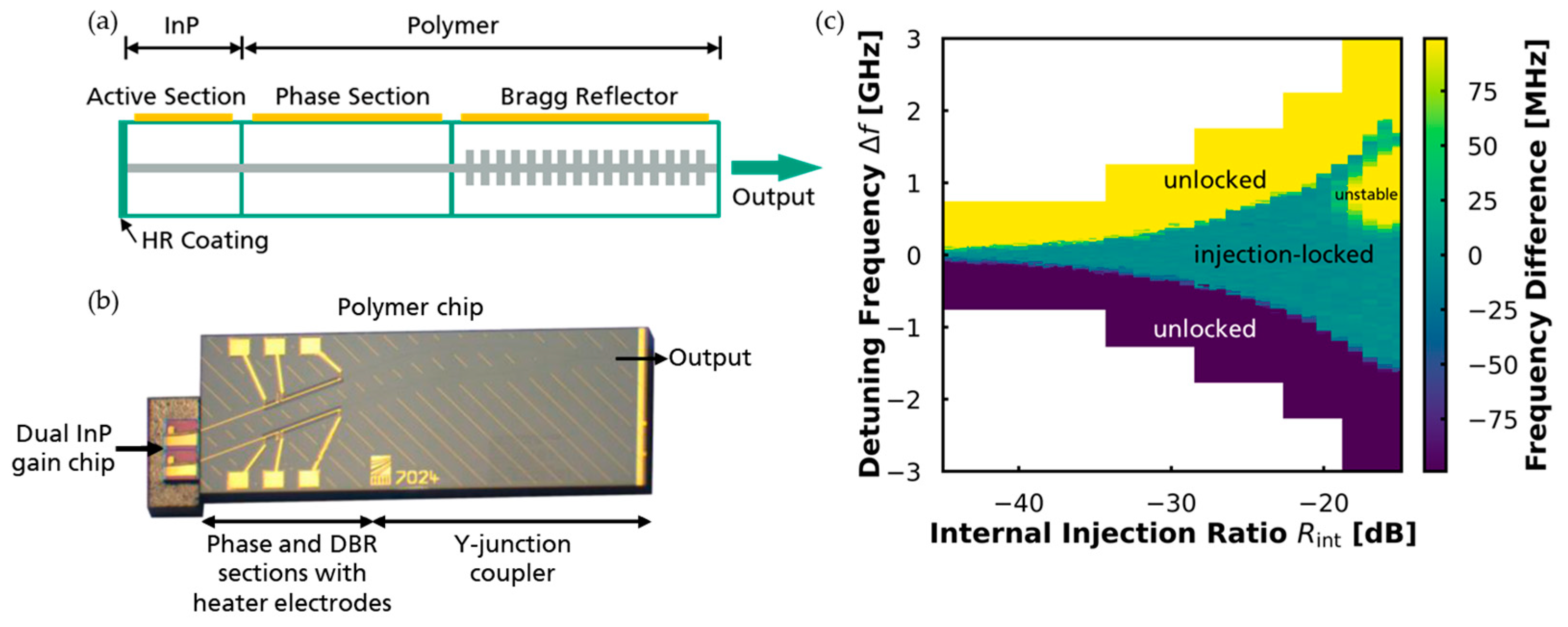
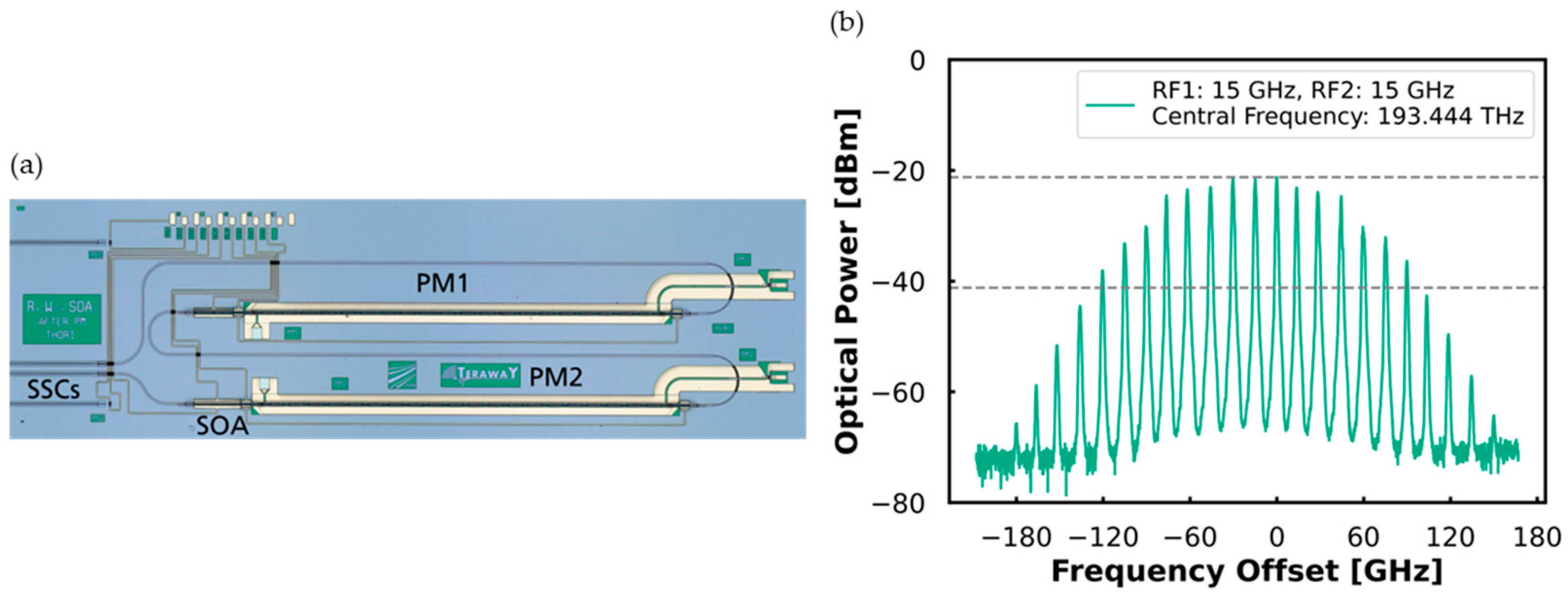
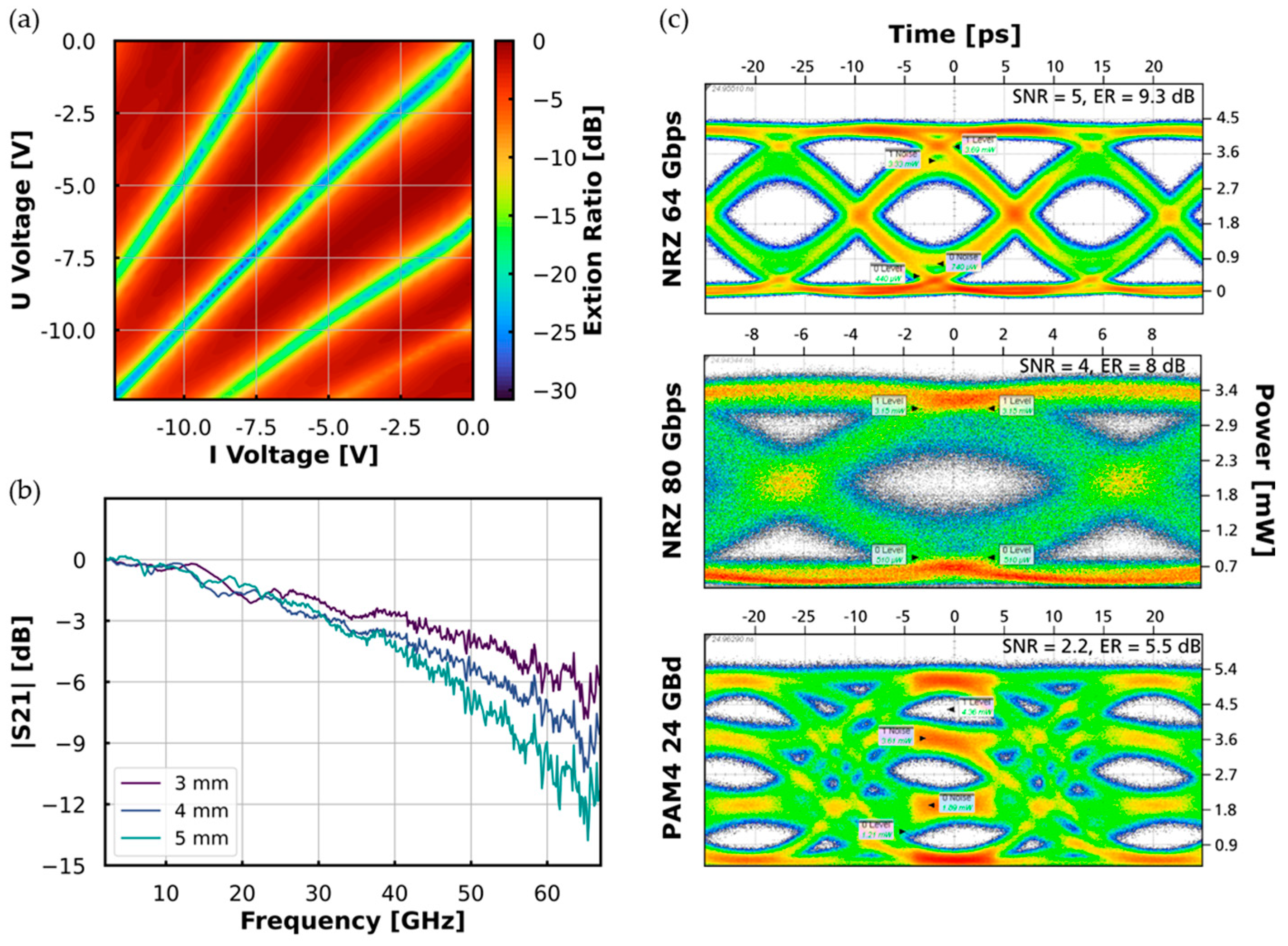
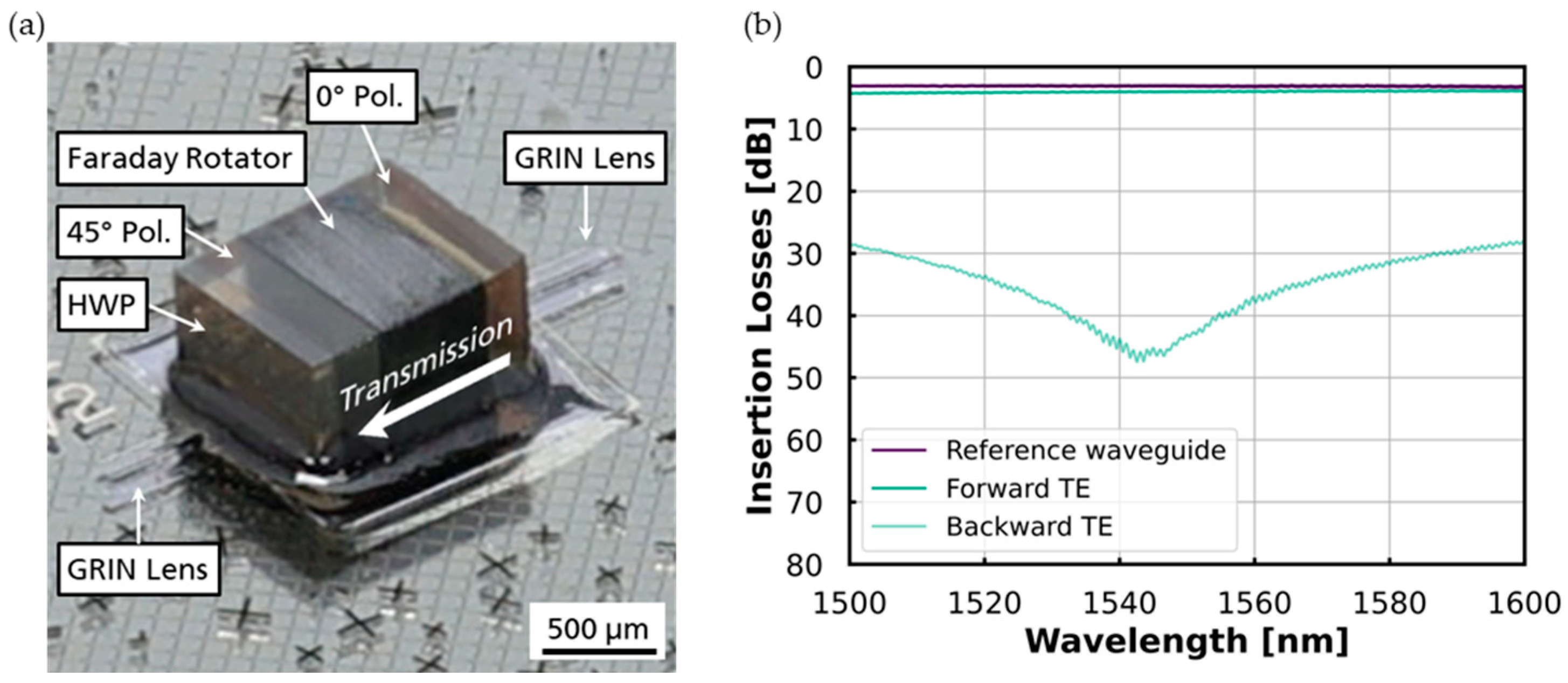


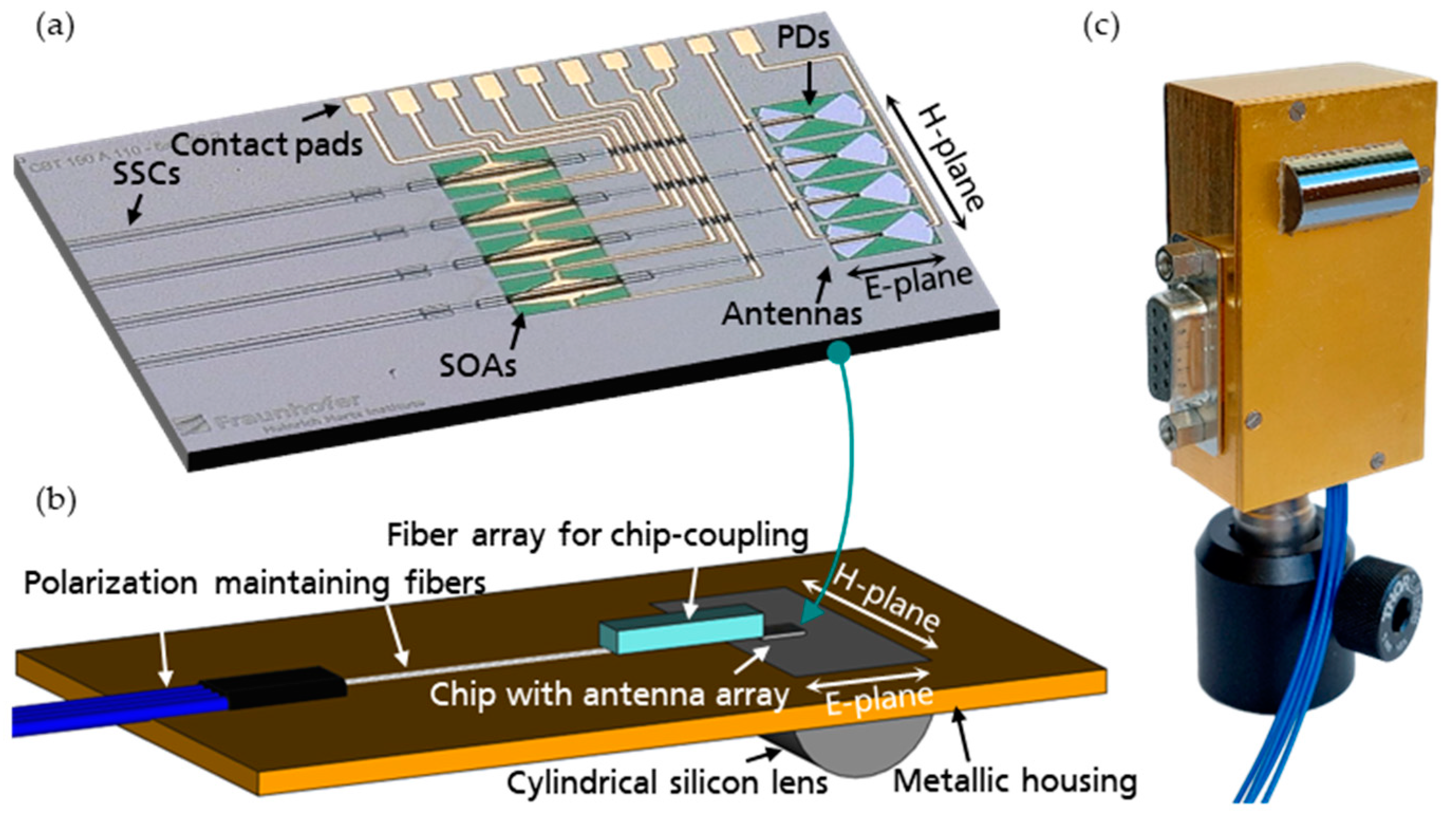
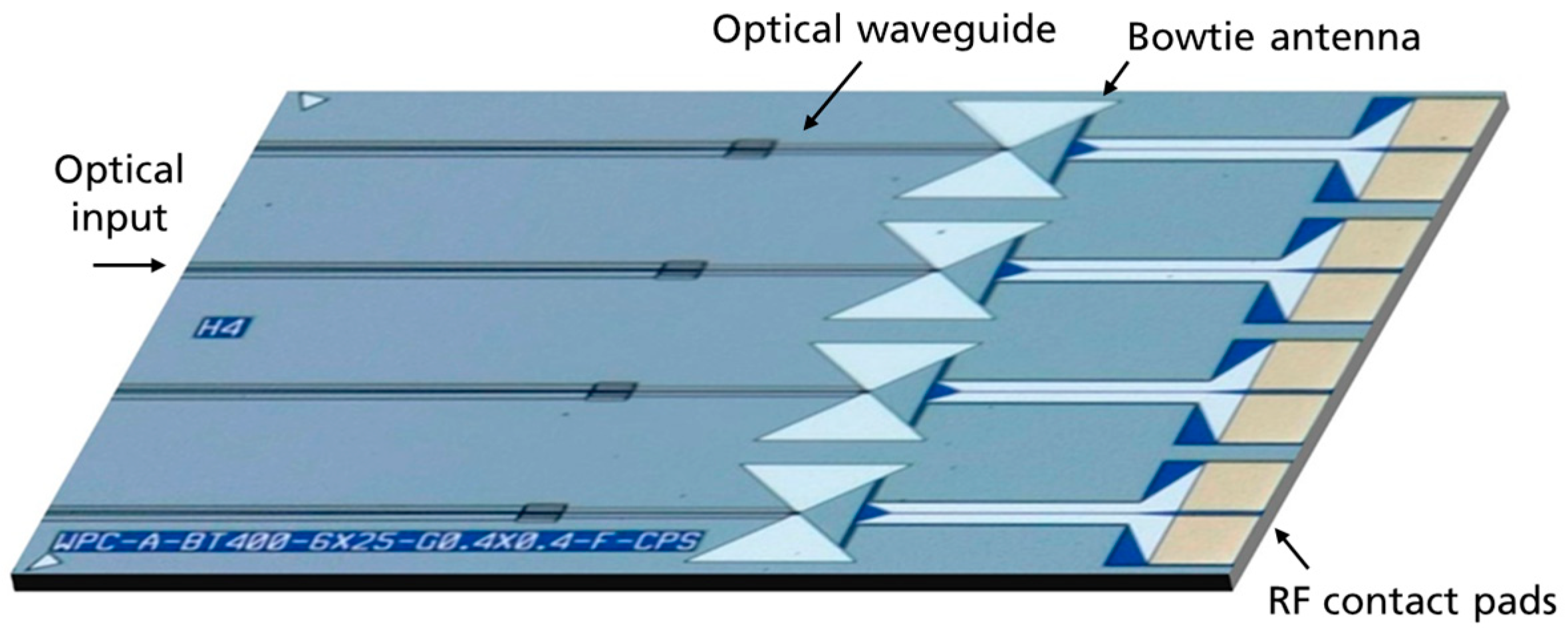
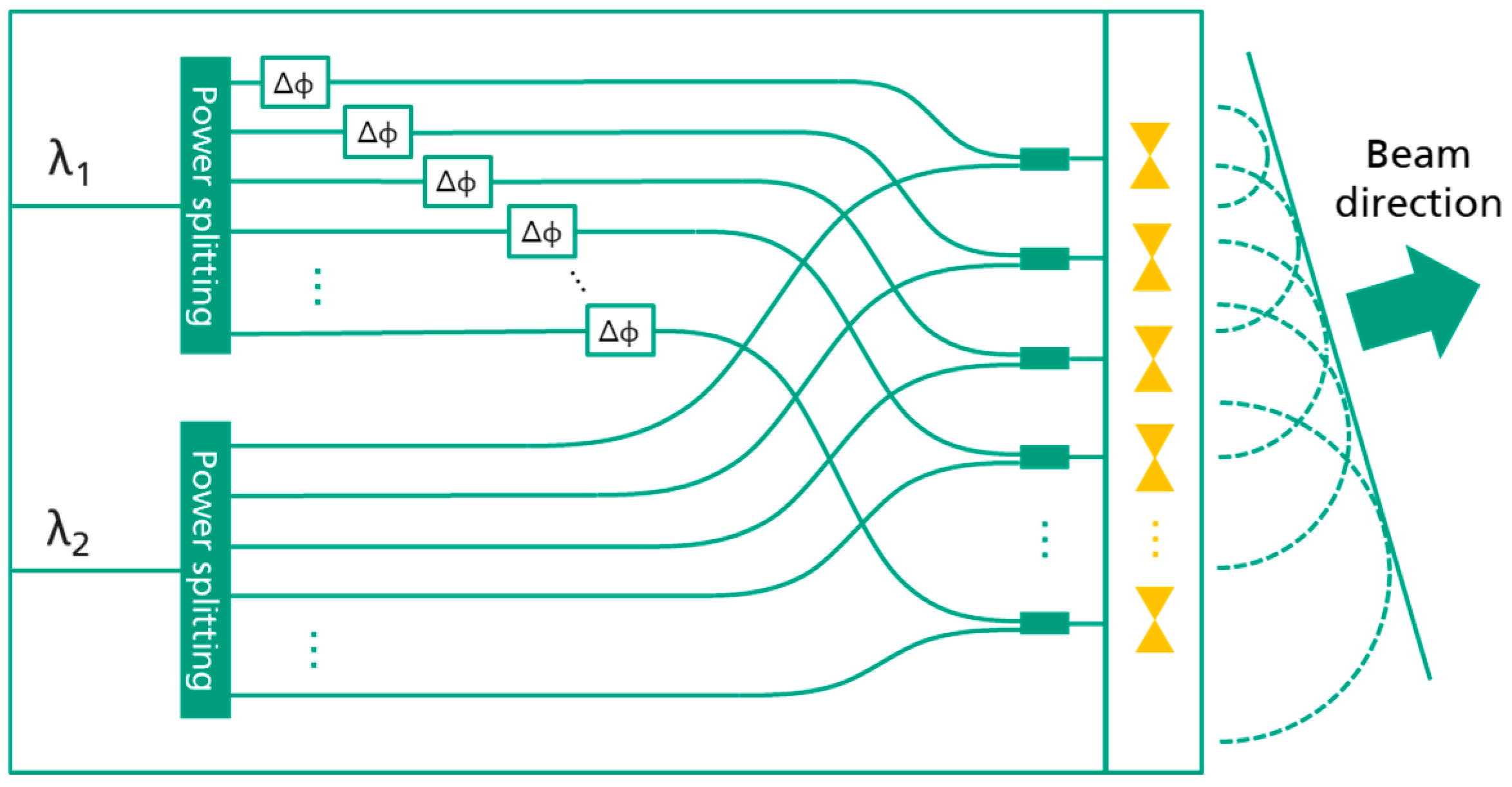
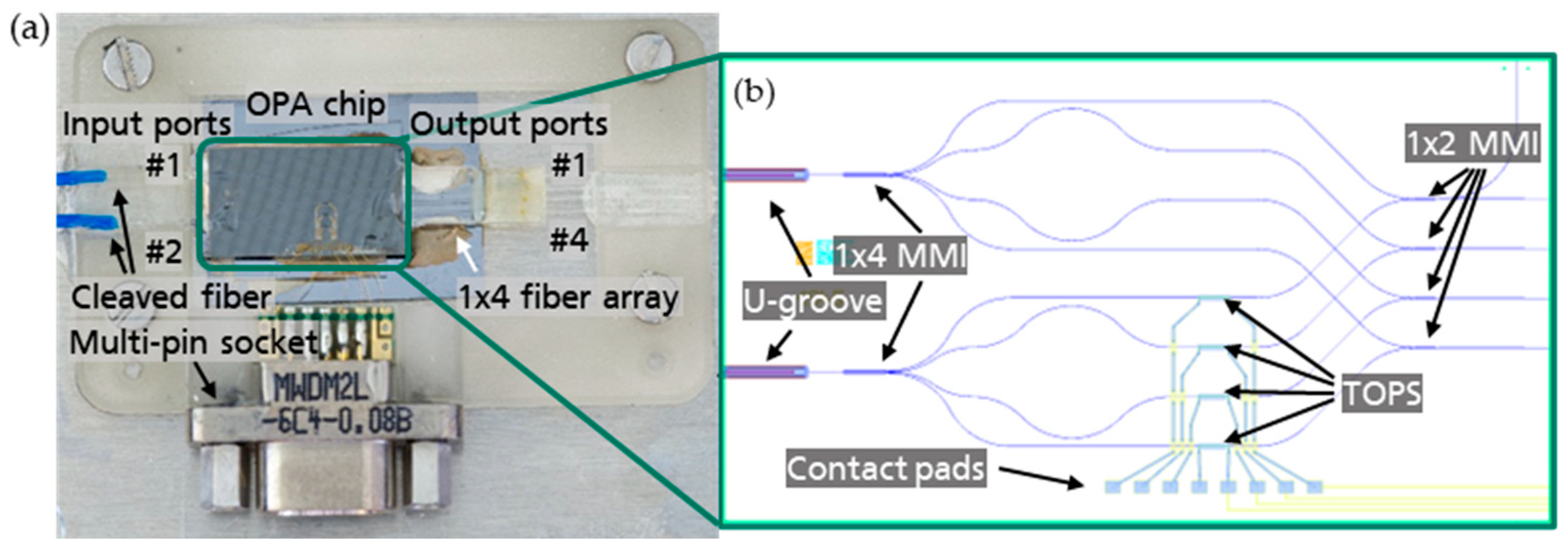
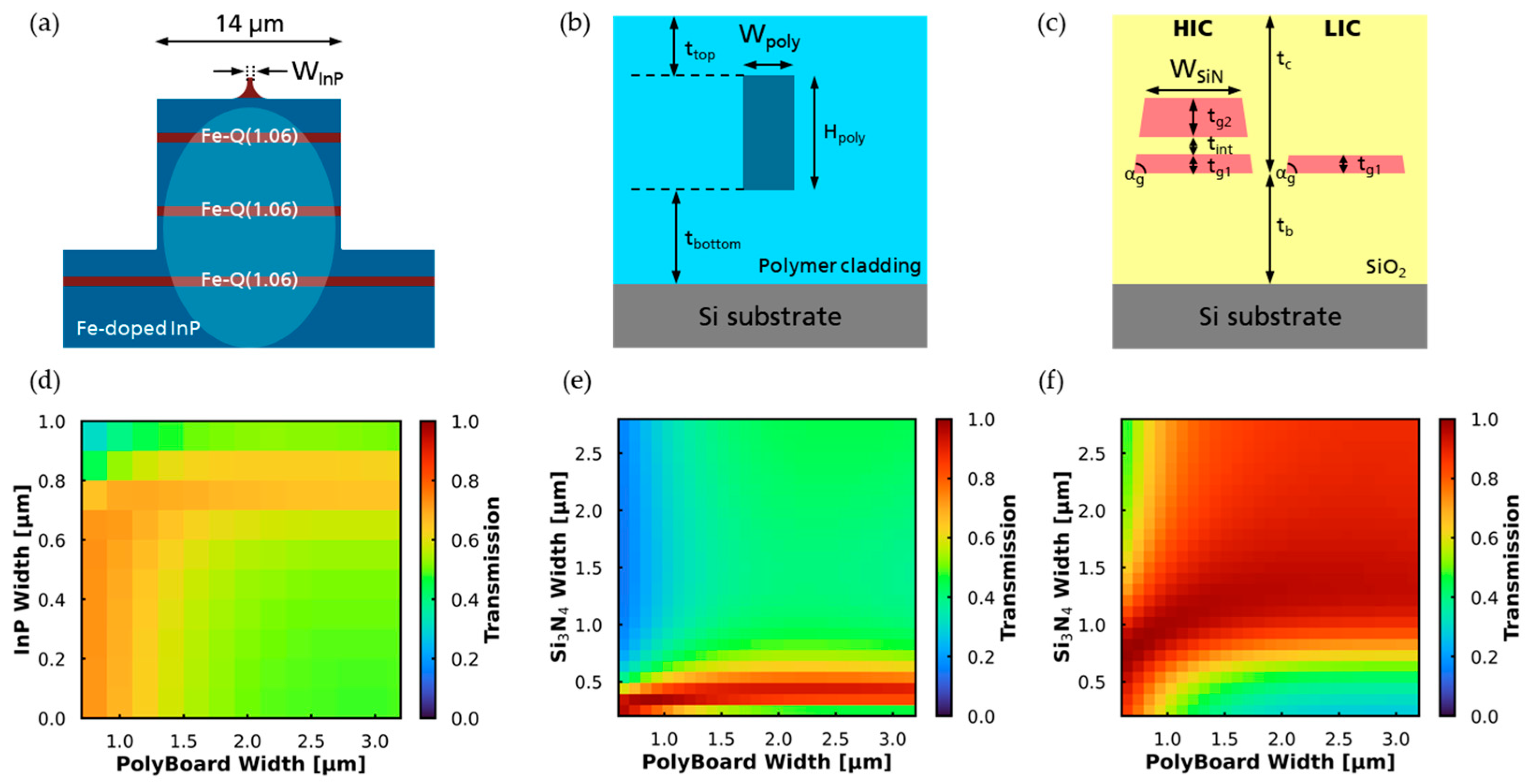
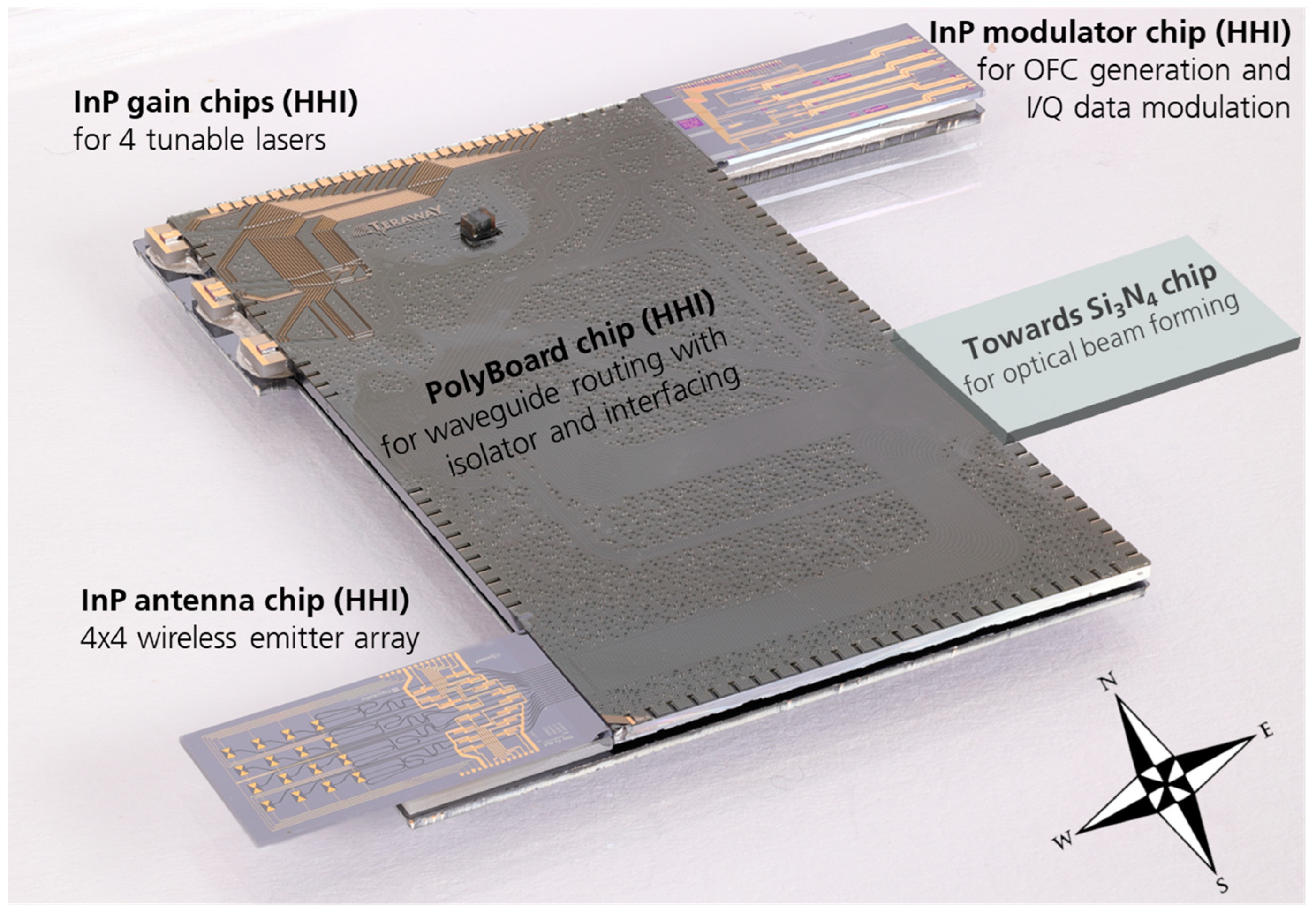
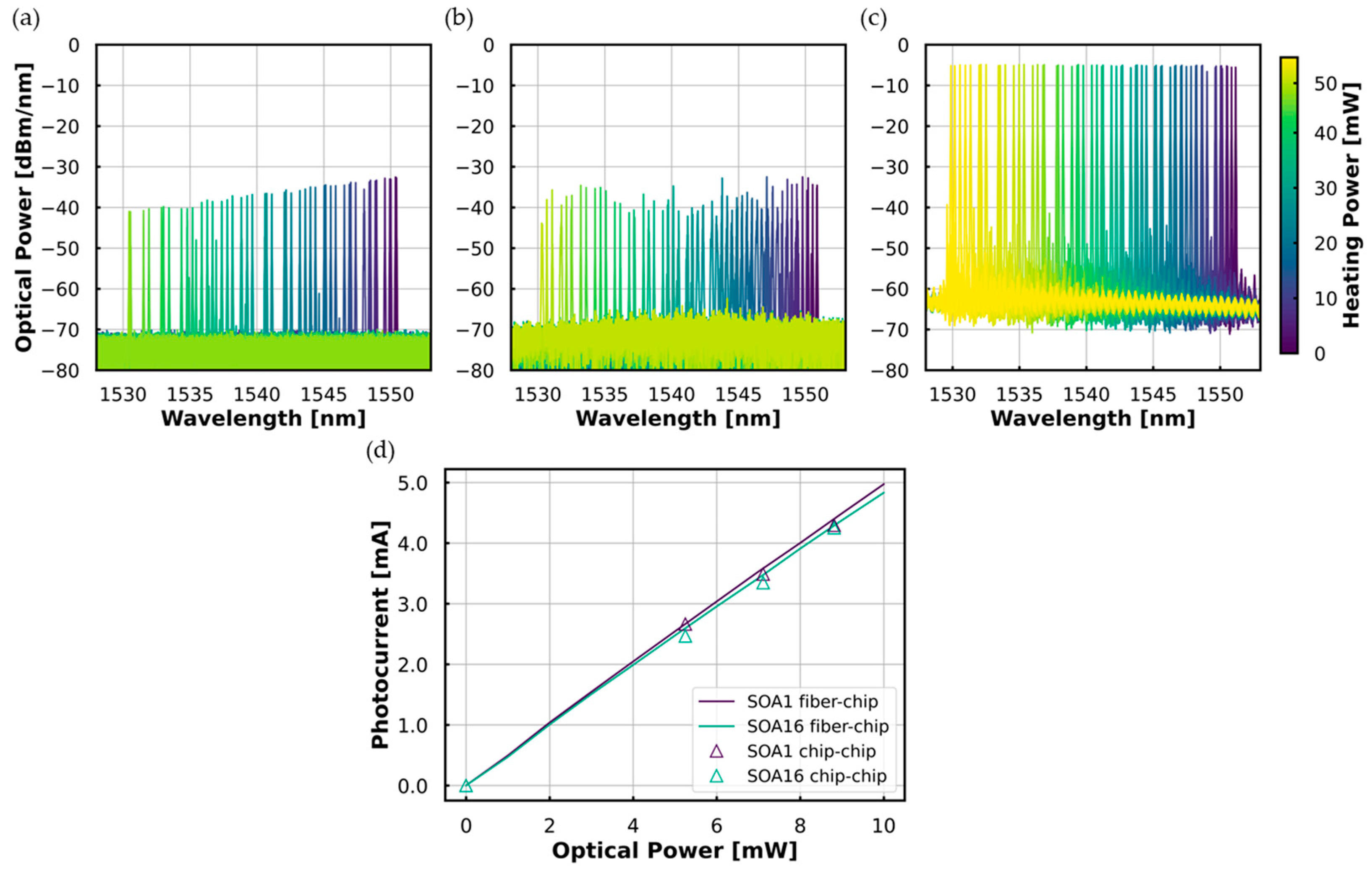

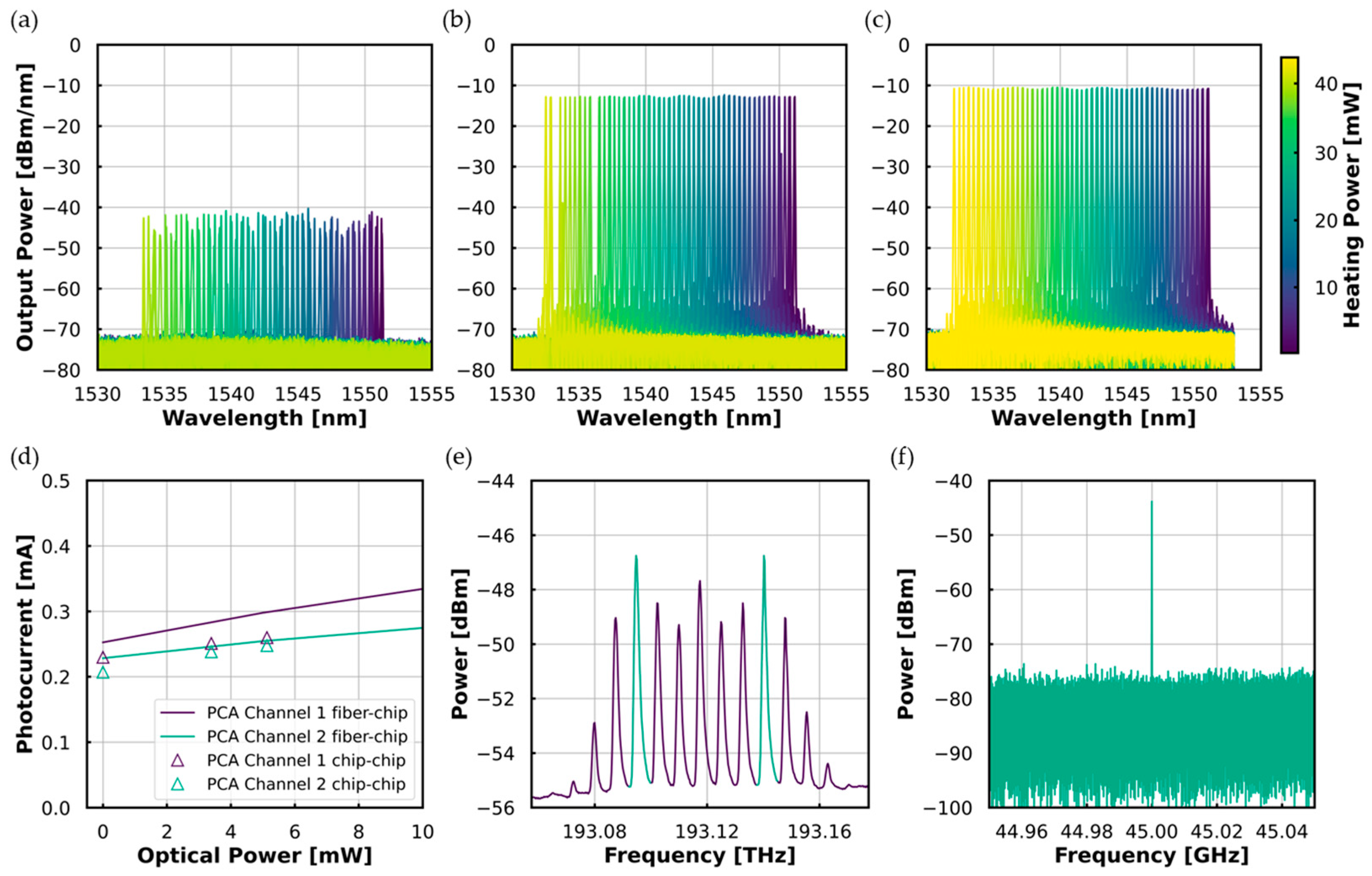
| Platforms | Waveguide Loss | Routing Capability | High-Speed Modulation | Tunable Lasers | Optical Isolator | O/E Functionalities (e.g., THz Antenna) |
|---|---|---|---|---|---|---|
| InP | + | + | +++ | ++ | N/A | +++ |
| PolyBoard | ++ | +++ | N/A | +++ | + | N/A |
| Si3N4 | +++ | +++ | N/A | +++ | N/A | N/A |
| Platforms | neff @1550 nm | MFDx,y [µm] | Waveguide Width [µm] | Simulated Coupling Loss Towards PolyBoard [dB] |
|---|---|---|---|---|
| InP [16] | 3.2 | (3.5, 4.4)–(10.0, 7.0) | [0.1–1.0] | 1.3 |
| PolyBoard | 1.46–1.45 | (4.3, 4.3)–(9.0, 7.8) | [0.8–3.2] | N/A |
| Si3N4 [17] | 1.535–1.446 | (1.5, 1.2)–(10.0, 10.0) | [0.8–3.7] | 0.1 |
Disclaimer/Publisher’s Note: The statements, opinions and data contained in all publications are solely those of the individual author(s) and contributor(s) and not of MDPI and/or the editor(s). MDPI and/or the editor(s) disclaim responsibility for any injury to people or property resulting from any ideas, methods, instructions or products referred to in the content. |
© 2025 by the authors. Licensee MDPI, Basel, Switzerland. This article is an open access article distributed under the terms and conditions of the Creative Commons Attribution (CC BY) license (https://creativecommons.org/licenses/by/4.0/).
Share and Cite
Qian, T.; Schuler, B.; Gupta, Y.D.; Deumer, M.; Andrianopoulos, E.; Lyras, N.K.; Kresse, M.; Weigel, M.; Reck, J.; Mihov, K.; et al. Hybrid Photonic Integrated Circuits for Wireless Transceivers. Photonics 2025, 12, 371. https://doi.org/10.3390/photonics12040371
Qian T, Schuler B, Gupta YD, Deumer M, Andrianopoulos E, Lyras NK, Kresse M, Weigel M, Reck J, Mihov K, et al. Hybrid Photonic Integrated Circuits for Wireless Transceivers. Photonics. 2025; 12(4):371. https://doi.org/10.3390/photonics12040371
Chicago/Turabian StyleQian, Tianwen, Ben Schuler, Y. Durvasa Gupta, Milan Deumer, Efstathios Andrianopoulos, Nikolaos K. Lyras, Martin Kresse, Madeleine Weigel, Jakob Reck, Klara Mihov, and et al. 2025. "Hybrid Photonic Integrated Circuits for Wireless Transceivers" Photonics 12, no. 4: 371. https://doi.org/10.3390/photonics12040371
APA StyleQian, T., Schuler, B., Gupta, Y. D., Deumer, M., Andrianopoulos, E., Lyras, N. K., Kresse, M., Weigel, M., Reck, J., Mihov, K., Winklhofer, P., Keuer, C., Emden, L. v., Amberg, M., Zawadzki, C., Kleinert, M., Nellen, S., Felipe, D. d., Avramopoulos, H., ... Schell, M. (2025). Hybrid Photonic Integrated Circuits for Wireless Transceivers. Photonics, 12(4), 371. https://doi.org/10.3390/photonics12040371





